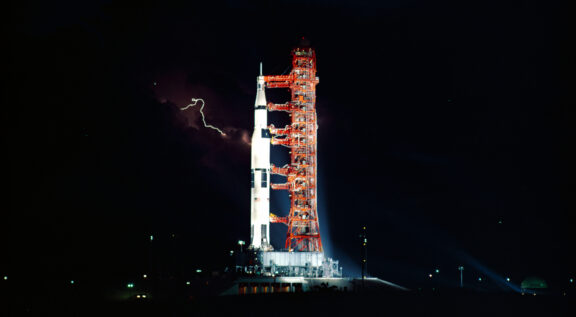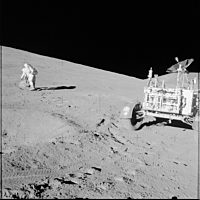Apollo 15 was the beginning of an end—the first of the final three crewed missions to the Moon in the 20th century. These final three were effectively Apollo 2.0, featuring hardware upgrades that extended both their duration and scientific return. The service module was now laden with scientific instrumentation; a beefier lunar module doubled the total time spent on the surface. NASA also debuted the motorized lunar rover, which extended the exploration range of its astronauts by a factor of five.

Originally envisioned to send 10 initial sorties to the surface and then establish a more permanent presence, America’s lunar ambitions were severely curtailed by the launch of Apollo 15. Three missions had already been canceled and increasing budgetary pressure from the Nixon White House called into question the futures of Apollos 16 and 17. For a brief period in the summer of 1971, Apollo 15 could have been the final mission to the Moon.
Political uncertainty did not trickle down to the mission itself. Apollo 15 was the most ambitious mission to the Moon yet, representing a new level of program maturity and operational confidence by NASA. It was the first of the “J-class” missions, which featured upgraded spacecraft that enabled longer stays at the Moon with greater scientific return.
The mission began on July 26, 1971 with the liftoff of the Saturn V rocket carrying Commander Dave Scott, Command Module Pilot Al Worden, and Lunar Module Pilot Jim Irwin. The rocket had been modified to loft thousands of additional kilograms (more than 4,000 pounds) of materials and supplies to the Moon, which included a full suite of scientific instruments on the service module, additional life support materials to support a three-day stay on the lunar surface, and, of course, the Lunar Roving Vehicle.

The landing site was a study in extremes. Dave Scott and Jim Irwin landed near a massive chasm in the lunar surface — Hadley Rille — created by ancient lava flows. Bounding them to the south were the Apennines, a soaring mountain chain towering upwards of 5 kilometers (16,000 feet) above the diminutive lunar module. The mountains and rille provided opportunities to collect samples from deep in the lunar bedrock and to study new types of geologic formations. It was also the most breathtaking lunar landing site to date. In the debate about where to land his mission, Dave Scott broke a tie in favor of the Apennine mountains, believing that all else being equal, exploration should favor beauty.

Scott and Irwin spent three days on the Moon and made three long scientific excursions, using the lunar rover to drive nearly 28 kilometers (17.4 miles). They climbed the foothills of the Apennines, flirted with the edge of the rille, and collected 77 kilograms (about 170 pounds) of lunar rocks and soil samples, including the so-called "Genesis rock" dated at more than 4 billion years old. The lunar roving vehicle — designed, tested, and engineered in a mere 17 months — performed well for its first outing. Its additional capacity supported an independent direct-to-Earth antenna which provided a live color television feed of their progress.

Not to be outdone, Command Module Pilot Al Worden performed complex measurements of the lunar environment from orbit. Using the upgraded suite of science instruments on the service module, he gathered detailed data on the Moon's topography, radiation environment and exosphere. Worden even released the first micro-satellite at the Moon to measure its magnetic field.
After spending three days on the Moon, astronauts Scott and Irwin blasted off from the surface to rejoin their fellow astronaut in orbit. The remaining flight home was uneventful, though Worder did perform a spacewalk in trans-lunar space in order to retrieve film from one of the service module’s scientific instruments.
The crew splashed down in the pacific ocean on August 7th, 1971, 13 days after their departure. It was the longest-duration Apollo mission to that point.
Apollo 15 Timeline
| Event | Time (UTC) | Date |
|---|---|---|
| Liftoff | 13:34:00 | 26 Jul 1971 |
| Earth orbit insertion | 13:45:44 | 26 Jul 1971 |
| Trans-lunar injection | 16:30:03 | 26 Jul 1971 |
| Lunar Orbit Injection Burn | 20:05:46 | 29 Jul 1971 |
| CSM/LM undocking | 18:13:16 | 30 Jul 1971 |
| LM lunar landing | 22:16:28 | 30 Jul 1971 |
| 1st EVA started | 13:13:17 | 31 Jul 1971 |
| 1st EVA ended | 19:45:59 | 31 Jul 1971 |
| 2nd EVA started | 11:48:48 | 01 Aug 1971 |
| 2nd EVA ended | 19:01:02 | 01 Aug 1971 |
| 3rd EVA started | 08:52:14 | 02 Aug 1971 |
| 3rd EVA ended | 13:54:00 | 02 Aug 1971 |
| LM lunar liftoff | 17:11:23 | 02 Aug 1971 |
| CSM/LM docked | 19:10:25 | 02 Aug 1971 |
| Transearth injection ignition | 21:22:45 | 04 Aug 1971 |
| Transearth EVA start (Worden) | 15:31:12 | 05 Aug 1971 |
| Transearth EVA end | 16:10:19 | 05 Aug 1971 |
| Entry | 20:32:54 | 07 Aug 1971 |
| Splashdown | 20:45:53 | 07 Aug 1971 |
Apollo 15 Cost
NASA estimated the following marginal costs for Apollo 15. Full costs of the Apollo program can be found on the "How Much Did the Apollo Program Cost?" page.
| original $ | inflation adjusted $ | |
|---|---|---|
| Command & Service Module | $65 million | $450 million |
| Lunar Module | $50 million | $345 million |
| Saturn V Launch Vehicle | $185 million | $1.3 billion |
| Science Experiements & Lunar Roving Vehicle | $40 million | $276 million |
| Operations | $105 million | $726 million |
| Total | $445 million | $3.7 billion |
Resources
Project Apollo
Starting with Apollo 7 in 1968 and culminating with Apollo 17 in 1972, NASA launched 33 astronauts on 11 Apollo missions. Twelve humans walked on the Moon.



 Explore Worlds
Explore Worlds Find Life
Find Life Defend Earth
Defend Earth


